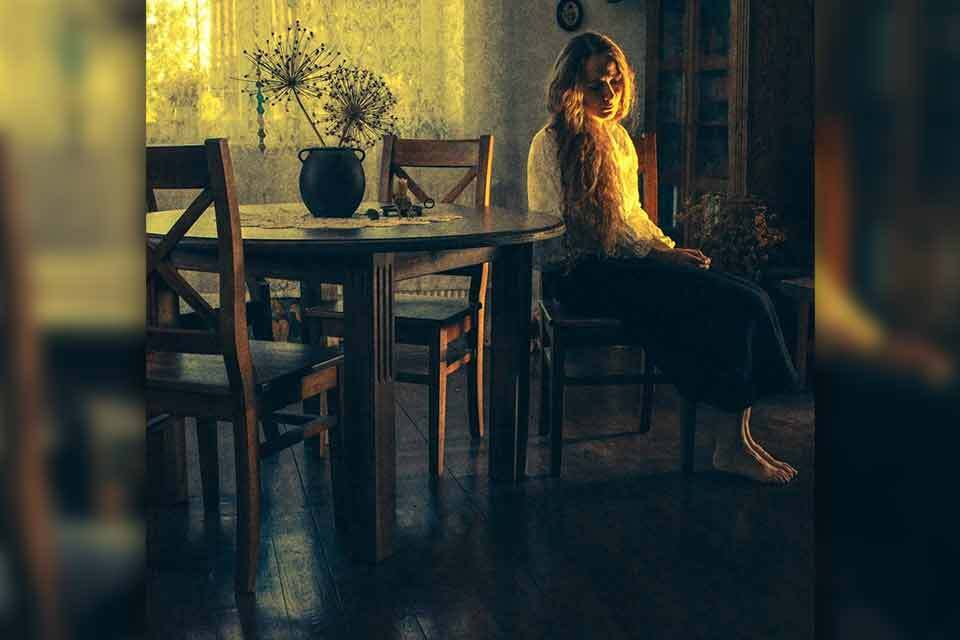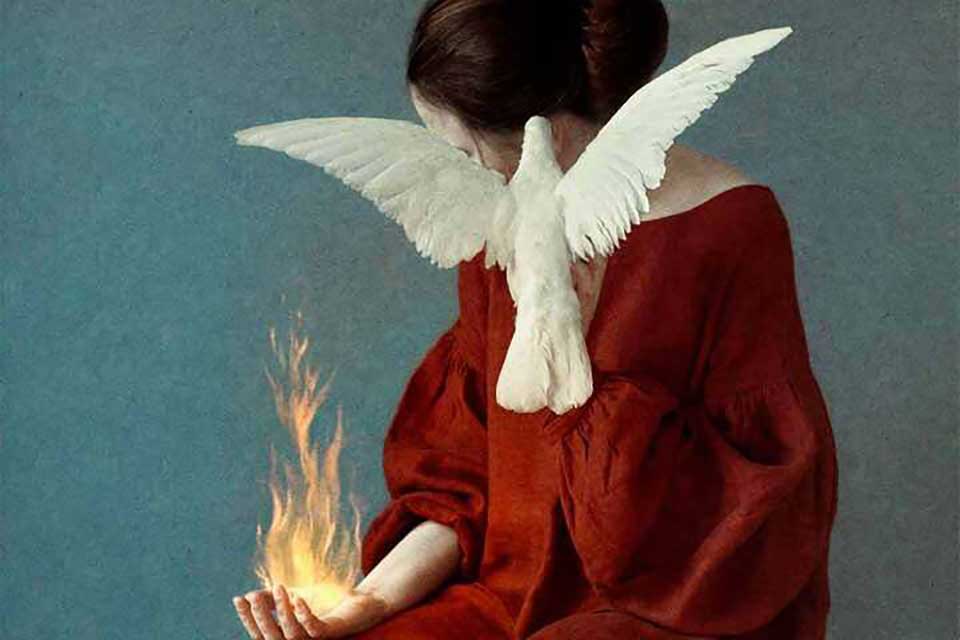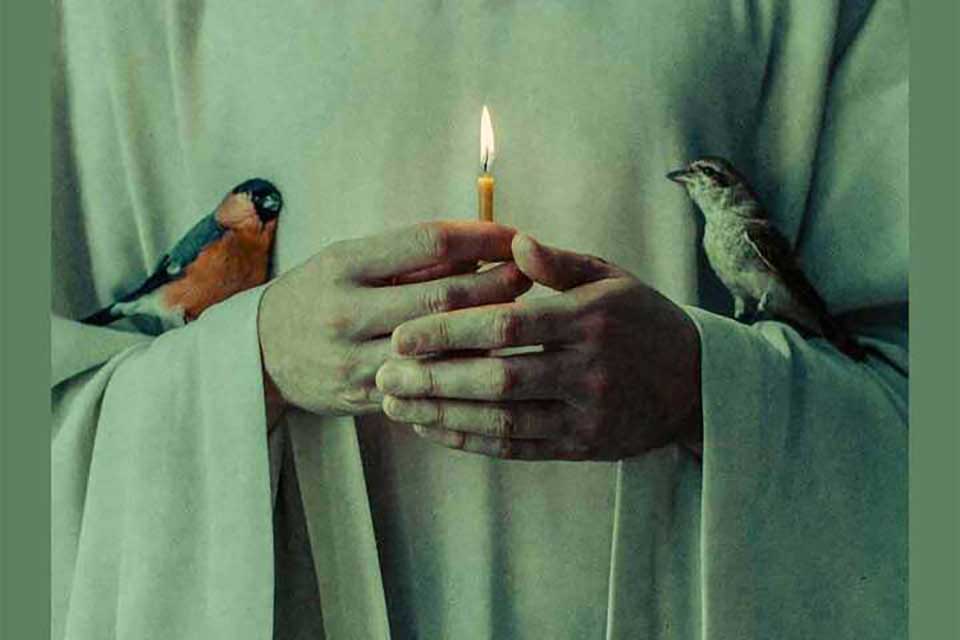Piercing the Veil: Laura Makabresku’s Mystical Testimony, by Yahia Lababidi

Whereas conflict, injustice, and religious fatigue proceed to poison the air, Yahia Lababidi finds a beauty-infused resistance within the surreal work of Polish photographer Laura Makabresku.
I’ve lengthy admired the surreal, sacral artwork of Polish photographer Laura Makabresku (born Kamila Kansy). However in current instances, amid escalating political noise and dispiriting violence, her serene photos have taken on a deeper resonance. When phrases fail, as they usually do, Makabresku’s painterly images really feel like restorative pilgrimages to a finer realm.
Makabresku identifies as a storyteller and creates haunting, generally hallucinatory scenes that really feel like visible psalms or quiet reminders, amid the chaos of contemporary life, of what’s indestructible. Her paintings inhabits liminal areas—between seen and unseen, waking and dreaming, presence and absence—inviting us to dwell at thresholds. We’re summoned into her enchanted world for a prayerful pause illuminated by candlelight, shrouded in gauze—to ponder topics which might be much less real-life portraits than apparitions: spirit-bodies caught between wound and marvel.
A pupil of magical realism and fairy tales, Makabresku attracts deep inspiration from mysticism. Her figures, imbued with a devotional undercurrent, resemble modern-day icons calling us to give up to the Unseen. It’s the spirituality of saints and martyrs, of longing and visions—Julian of Norwich meets Sylvia Plath. In her evocative visible lexicon, birds, doves, wings, and feathers recur regularly: symbols of the soul in flight, messengers of peace, and echoes of the Holy Spirit. As somebody personally enamored of winged creatures and who tends to see our feathered associates as angels in disguise, I’m particularly drawn to how this delicate artist facilities avian creatures amid grounded struggling.
A pupil of magical realism and fairy tales, Makabresku attracts deep inspiration from mysticism.
There may be one Makabresku picture I’ve returned to virtually each day these previous turbulent months, and every time, it places my coronary heart comfortable. Vigil depicts a robed determine—monastic, androgynous—holding a slender lit candle shut, as if guarding it in opposition to the encroaching darkish. Small, colourful wild birds (most definitely sparrows or finches) delicately perch on the determine’s forearm, gazing on the flame and nestling within the broad sleeves, as if drawn by some invisible liturgy.
I believe there is likely to be an echo of St. Francis right here—patron of creatures and buddy to the brokenhearted. Whether or not rendered in spectral black-and-white or bathed within the smooth heat of colour, each variations of this picture exude a steadying tenderness and the reassurance of formality. It could be unclear whether or not we’re witnessing mourning or prayer, however we sense that some quiet religious balancing act is going down. To take care of this vigil with humble consideration and reverence is, I imagine, to partake in its calming advantages.
In instances of upheaval, private or collective, I usually flip to artwork as a type of silent scripture. Makabresku’s spectral compositions remind us to not be deceived by the darkness of our age and that the sacred nonetheless breathes persistently amongst us. As a visible poet, Makabresku makes use of her digicam to not doc our mutilated world however to consecrate it. Her ethereal artwork evokes a sacred interiority: timeless figures wrapped in linen, captured in states of ache or ecstasy; legendary and historic tableaux the place respiration slows and the soul attracts close to to its Supply.
As a contemplative artist, it’s evident Makabresku attracts on that capital of riches, silence. And, in flip, her visible meditations silence us. By affiliation, I’m reminded of this smart counsel by beloved American poet Wendell Berry, present in his poem “How you can Be a Poet (to remind myself)”:
Settle for what comes from silence . . .
Of the little phrases that come
out of the silence, like prayers
prayed again to the one who prays,
make a poem that doesn’t disturb
the silence from which it got here.
Equally, the human figures in Makabresku’s prayerful artwork are remodeled into vessels of transcendence, rendering the abnormal right into a state of the numinous. By the holy hush of her visible meditations, she transports us to a spot of infinite persistence the place we would replicate upon the radiance of our wounds and the way the sunshine enters them.
Whereas conflict, injustice, and religious fatigue proceed to poison the air, Makabresku’s work appears like a type of beauty-infused resistance. In our age of unholy brutality and destruction, her artwork elevates, a fragile testomony to the everlasting.
I reached out to Laura to ask concerning the spirit behind her photos. Her solutions, like her artwork, are tender, elliptical, and luminous. What follows is a quick alternate with an artist whose work presents a quiet however highly effective type of grace.

In our age of unholy brutality and destruction, Makabresku’s artwork elevates, a fragile testomony to the everlasting.
In Her Phrases: Laura Makabresku
Yahia Lababidi: Your images usually really feel like silent prayers or visible psalms. Do you expertise your art-making as a religious act?
Laura Makabresku: Sure, I usually expertise image-making as an expression of my deepest religious longing—the will that at some point I’ll turn into as I seem in a few of these photos—that my soul could also be united with God in love. These photos are sometimes saturated with longing, a silent and on the similar time fervent cry to God, a continuing seek for His presence in all the pieces, together with my inventive work. On one hand, they categorical a need for unity, however on the opposite, additionally they bear witness to an precise expertise of His closeness, a partial and nonetheless incomplete success of that need, but one which sustains hope.
Lababidi: In a time when the world feels more and more brutal and chaotic, your photos provide a quiet, sacred refuge. What position do you imagine magnificence performs in darkish instances?
Makabresku: I imagine that magnificence heals, lifts the spirit, presents consolation, soothes the ache of existence, and factors towards that means. I’m pondering not solely of magnificence expressed by way of artwork but additionally of magnificence perceived in one other particular person, in a gathering, in nature.
Lababidi: Your work is steeped in stillness, struggling, and symbolism. How do ache and transcendence meet in your visible language?
Makabresku: I believe struggling is an inseparable a part of our lives. That’s why I don’t attempt to keep away from this “motif” within the tales I inform by way of photos or phrases. We don’t all the time discover that means in painful or troublesome experiences—even when we’re folks of religion, there are moments when darkness, worry, and struggling appear to devour our ideas and even our religion. But deep inside, I sense that the flame of religion and hope inside us is sustained not by human energy however by God’s energy. That’s why it burns even when our minds can’t understand it and our emotions can’t sense it.
The actual fact that I can attempt to categorical ache . . . to share it with one other particular person—whether or not by way of easy phrases or metaphor, by way of picture—is an expertise that reaches into the depths of the soul and transcends the purely bodily. Struggling is a thriller. I don’t attempt to unravel it. As an alternative, I attempt to weave it right into a story higher than myself and my very own expertise—the story informed within the Gospel. In its mild, even essentially the most painful experiences can tackle that means.
Lababidi: There are recurring motifs in your artwork—veils, wounds, candles, birds. What do these symbols imply for you or level towards?
Makabresku: Sure . . . all through the time I’ve been creating, one thing like a private visible vocabulary has developed—motifs and symbols that return repeatedly. For me, the closest ones are these linked with wounds, blood, the center, birds, naked ft, and an empty vessel awaiting grace. After all, these symbols may be interpreted on a cultural stage—linked to archetypes, the Bible, myths, and fairy tales. However for me, they primarily carry religious that means—they’re vessels for religious truths and mysteries.
I take advantage of them principally intuitively . . . and freely. I don’t goal to create photos that perform as riddles to be intellectually decoded. I imagine that even folks exterior of the Christian custom can grasp and expertise the symbols in my work on a deeper stage. It doesn’t should occur by way of the mind. I belief that the intention behind my photos (which is a type of prayer) is a type of power that may provide one thing good to those that obtain them.
Lababidi: Do you are feeling a part of a lineage of mystic or visionary artists? Are there writers, painters, or saints who’ve formed your internal world?
Makabresku: It is dependent upon the way you perceive the phrase “mystic.” To me, mystics are individuals who dwell in God’s presence in each day life, who can see God’s motion in all the pieces, who love silence, and are open to like and self-giving. I really feel that the phrase “mystic” in on a regular basis language has come to explain folks with extraordinary or spectacular presents—visions, ecstasies, religious consolations. Or artists-prophets with impressed genius. Effectively . . . I don’t see myself that method. I’m a easy woman, with no formal artwork training. I don’t expertise visions or ecstasies. I see and expertise myself fairly as a sinner to whom God, daily and each second, reveals immense love, tenderness, and mercy. And the consolation I obtain from Him, I attempt to share with others—by way of artwork, sure, but additionally by way of abnormal gestures, phrases, and presence.
As for individuals who have formed my internal world—there are numerous lovely souls to whom I owe a lot. . . . To begin with, I consider the Carmelite saints, as a result of that spirituality is closest to my coronary heart and method of feeling: St. John of the Cross, St. Teresa of Ávila, St. Thérèse of Lisieux, St. Elizabeth of the Trinity. . . . I additionally owe a lot to the nice lecturers of prayer—particularly the Desert Fathers—but additionally writers like Thomas Keating, Thomas Merton, Henri Nouwen, Meister Eckhart, Charles de Foucauld, Kahlil Gibran, John Chapman, Jacques and Raïssa Maritain, Catherine Doherty, and lots of extra. . . . I must also point out artists like Rainer Maria Rilke, Andrei Tarkovsky, and Arvo Pärt.
Lababidi: Do you create with a selected viewer or feeling in thoughts, or is your work extra like a personal providing—to the divine, to your self?
Makabresku: I believe, ultimately, all of these facets are woven into my inventive course of—my relationship with God, my relationship with others, and my very own self-reflection and therapeutic. Generally a kind of motivations turns into extra dominant at a given time in my life, however often they continue to be in concord. I might be mendacity if I mentioned I create solely for the glory of God. There’s nonetheless plenty of ego concerned within the course of, plenty of trying to find myself. . . . However I attempt to replicate on that continuously, to maneuver towards focusing much less on myself and extra on doing good, providing consolation, and easily sharing the wonder and divine presence that I personally expertise in life.
Lababidi: Lastly, what nourishes you—spiritually or artistically—in these instances?
Makabresku: Above all, I believe it’s private prayer—by which I imply deep, silent prayer, rooted in intention and openness to God’s presence and motion. Religious studying additionally sustains me and tunes my coronary heart to stay attentive and conscious in on a regular basis issues. I additionally attempt to take care of the hygiene of my thoughts—to keep away from cluttering it with too many stimuli, info, photos, and sounds. That doesn’t imply I keep away from tradition or modern artwork, however I attempt to interact with it carefully. You’ll be able to’t devour all the pieces. It’s higher to absorb somewhat and savor its style extra deeply.

I imagine our incapacity to really feel reverence earlier than the Thriller is on the coronary heart of our time’s particular barbarism.
Postlude: Artwork as Prayer in Troubled Instances
American author William S. Burroughs wrote of the “Ugly Spirit,” a pervasive, damaging, malevolent pressure that embodies cruelty, dehumanization, and chaos. This corrupting affect distorts actuality, feeding on struggling and perpetuating cycles of violence, oppression, and decay, usually manifesting in each societal programs and particular person psyches.
Residing as we do within the grip of this Ugly Spirit—the harshness and ethical degradation that Burroughs describes in his disturbing work—we discover ourselves underneath a shadow that threatens to eclipse the sunshine. This spirit of distortion and cruelty appears to have taken root not simply in our exterior realities however in our collective consciousness. It permeates the air we breathe, feeds the information cycles, and, at instances, feels as if it had been possessing us.
But, within the face of this consuming darkness, an indomitable magnificence soars, rising above the sordid world to reassure us of what stays unassailable: incorruptible hope. Laura Makabresku’s work stands as a mystical testomony to this aesthetic resistance. Her images, every an invocation, usually are not mere reactions to the world’s violence; they’re odes to one thing unshakable and chaste—magnificence’s regular persistence within the face of what seeks to annihilate it. Her artwork doesn’t deny the injuries that we supply, nor the unhappy instances we stay in. It speaks past them, to a spot untouched by this Ugly Spirit.
I imagine our incapacity to really feel reverence earlier than the Thriller is on the coronary heart of our time’s particular barbarism. In a world more and more defiled by the profane, artwork like Makabresku’s turns into a type of religious safety, a talisman that shields our souls from despair. Such otherworldly artwork is a sanctuary we go to in order that we will return to this world, spiritually refreshed.

0 Comment